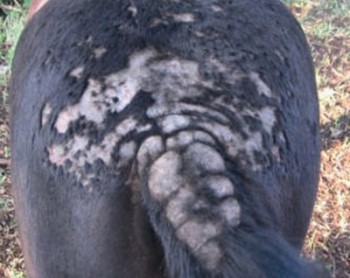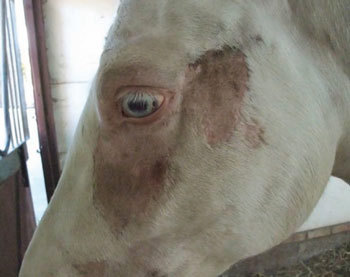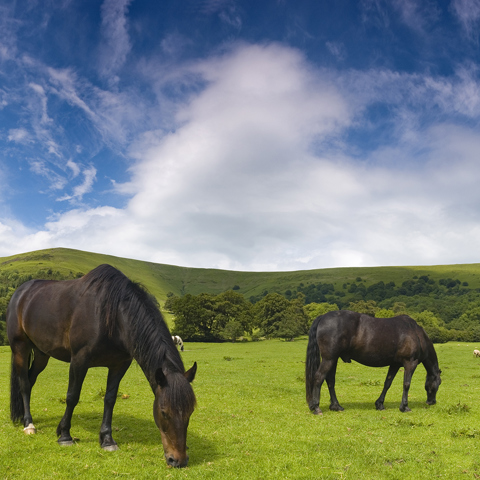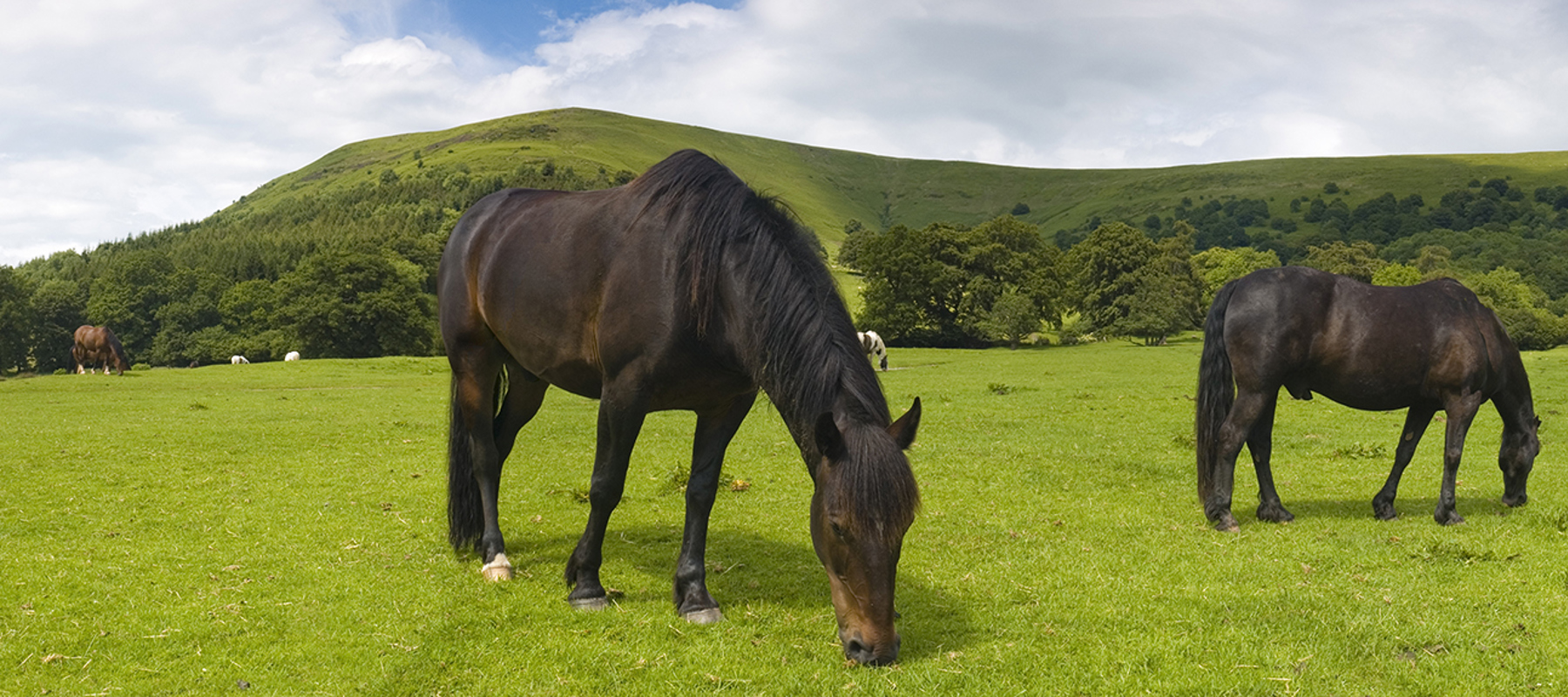What is sweet itch?
Sweet itch is an allergic reaction to the protein in the saliva of biting midges (culicoide) but may include other blood-sucking flies and insects. The allergy creates an irritable and sore skin condition (dermatitis) and affects the mane and tail areas of the horse where the midge bites, whereas other biting insects focus on the stomach region1.
Sweet itch can affect all breeds and types of horses, ponies and donkeys and can be genetic, meaning some horses are at increased risk of developing the condition. Breeds such as the Belgian warmblood2, Icelandic horses3 and native ponies, such as the Exmoor4, are at increased risk.
Advice specific to donkeys is available from The Donkey Sanctuary.
What are the signs of sweet itch?
Horses are mostly affected between March-November when the biting insects are most active, as the temperature is warmer and the air is humid.
Horses predominantly show signs of sweet itch at the base of the mane, withers, tail, face and ears, although some horses may also show signs on their belly, chest and groin5. These are the areas where insects will normally bite and feed from the horse.

Physical signs
- Excessive, intense itching, also known as pruritus. This can be shown as rolling, rubbing on objects such as fencing, trees and stable doors and structures or excessive grooming
- Tufted hair
- As the condition progresses, skin thickens, folds develop and the hair becomes sparse and coarse with flaky dandruff
- Hair loss can occur through scratching and the skin may become inflamed, crusty and sore, with broken skin potentially leading to infection

- Crusty and weeping wounds
- Inflamed skin
- Vigorous tail swishing and shaking of the head in an effort to keep insects away.

Behavioural signs
Due to being uncomfortable with the excessive itching and self-trauma, some horses with sweet itch show changes in their behaviour including:
- Irritability
- Restlessness
- Anxiety
- Aggression
- Lethargy
Diagnosis
The presence of these signs is typically used to diagnose sweet itch, but many other allergies show similar symptoms so further tests from a vet may be necessary to identify what’s triggering the reaction.
Accurate diagnosis is best done under veterinary supervision as the severity of sweet itch varies6.
Management and control
There’s currently no cure for sweet itch, and so it’s a condition that must be carefully managed as it’s recurrent each year.
Preventing contact with biting insects
chevron-down
chevron-up
The most effective way of managing sweet itch is by reducing the possibility of contact between the midges and the horse:
- Avoid areas that are likely to attract midges; standing water, woodland areas, compost or muck heaps, areas with other livestock and ensure good pasture management to remove droppings7.
- Shelter from dusk until after dawn, especially in hot and humid conditions, as these are the times midges are most active7.
- If stabled, placing an ultra-fine bug net over doorways and any windows will reduce the number of midges from entering7 .
- Installing fans, if safe to do so, in the horse’s stable will also reduce contact with midges, as they are very poor fliers7.
- Fly sprays with pyrethroid, permethrin or deet are generally more effective to deter midges from landing on the horse, however these should not be used on broken skin as it can cause irritation. It’s important to follow manufacturer’s guidelines and use necessary amounts — seek advice from a vet if unsure1.
- Fly rugs and fly masks, that cover as much of the horse as possible, will reduce the amount of the horse’s skin that is exposed to midges7. Zebra-print fly rugs have also been shown to be very effective at reducing fly bites due to the thin, irregular stripes confusing the flies8.

Soothe and ease itching
chevron-down
chevron-up
Soothing and reducing symptoms can help your horse be more comfortable and reduce irritability.
- There are many shampoos available that cater for sweet itch and can be used to soothe itching.
- Sprays containing humectant or emollient can help soothe itching.
- Steroid creams can be used to relieve itching as well as shampoos and creams that contain antihistamines, however this must be discussed with a vet first.
Medication
chevron-down
chevron-up
While there’s no cure for sweet itch, a vet may be able to recommend medications to ease the symptoms.
-
Desensitisation injections can sometimes be offered, which aims to reduce the severity of the allergic reaction (often called immunotherapy). This should be further discussed with your vet.
- Antihistamines may be prescribed by a vet to reduce swelling and itching but shouldn’t be used alone or for long term use. Anti-inflammatory drugs and corticosteroids are other options that may be prescribed.

References
chevron-down
chevron-up
- Marsella, et al., 2023. Equine allergic skin diseases: Clinical consensus guidelines of the World Association for Veterinary Dermatology. Veterinary Dermatology, 34, (3), pp. 175–208.
- Peeters, L.M., et al 2015. Genetic parameters and estimated breeding values of insect bite hypersensitivity in Belgian Warmblood horses. The Veterinary Journal, 206(3), pp.420-422.
- Eriksson, S., et al 2008. Genetic analysis of insect bite hypersensitivity (summer eczema) in Icelandic horses. Animal, 2(3), pp.360-365.
- Andersson, L.S., et al 2012. The same ELA class II risk factors confer equine insect bite hypersensitivity in two distinct populations. Immunogenetics, 64(3), pp.201-208.
- Cox et al., 2023. Insect Bite Hypersensitivity in Horses: Causes, Diagnosis, Scoring and New Therapies. Animals, 13(15).
- Coates, H., 2017. Dealing with sweet itch and other summer allergies in horses
- Avonvale equine vet practice, 2023. Sweet Itch – Treatment & Management Tips
- Caro, T. et al, 2023. Why don't horseflies land on zebras? Journal of Experimental Biology, 226(4).




